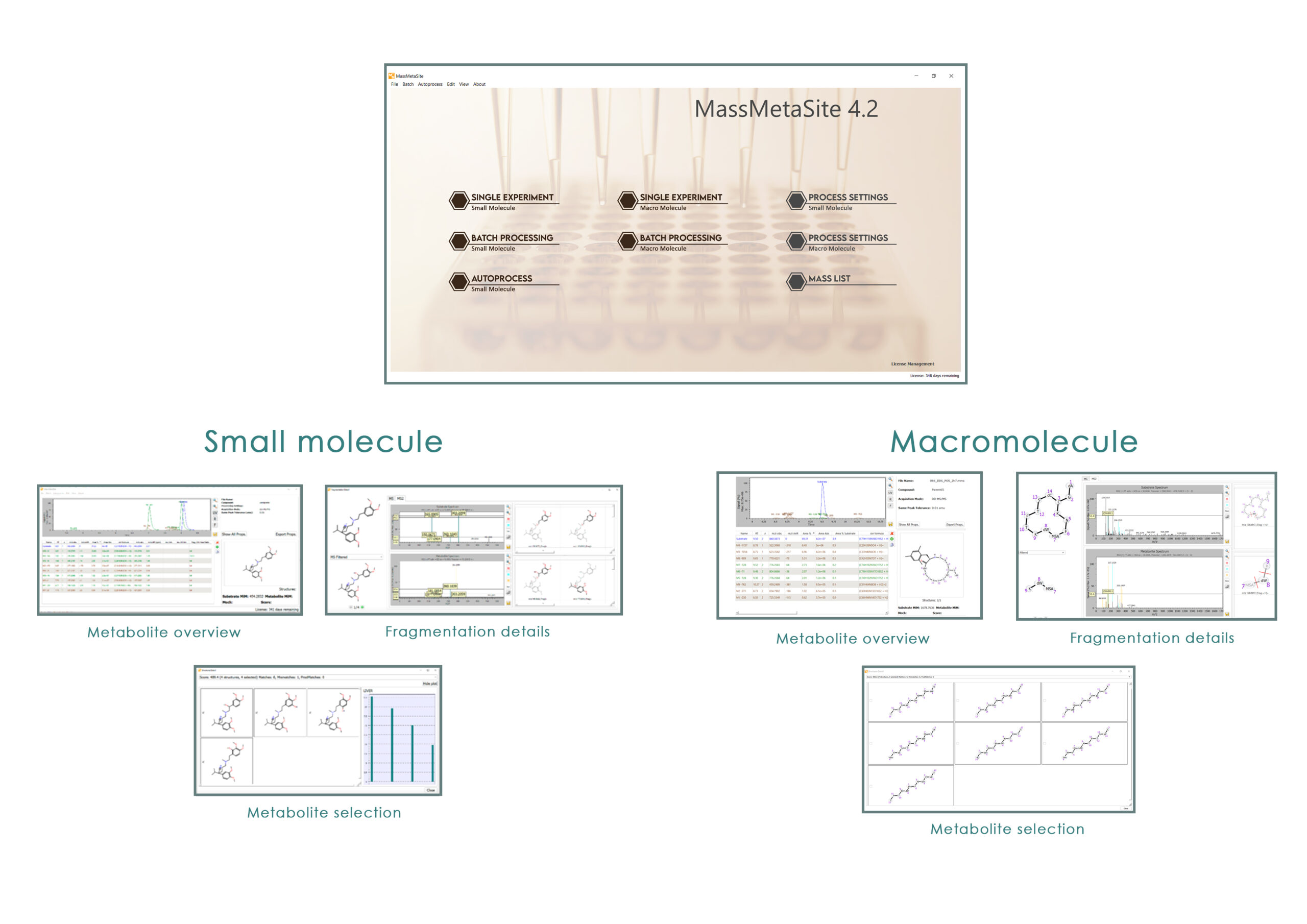

High-Throughput MetID
MassMetaSite is an established approach for the automatic identification of metabolites for small molecule and peptides using Liquid Chromatography – Mass Spectrometry, UV, fluorescence and radio-chromatogram data, reducing manual analysis from several hours to only a few minutes per compound. The program is able to assign chemical structures to each automatically detected chromatographic peak based on the MS and MS/MS fragmentation pattern of the substrates and metabolites. It can process from multiple vendors: Agilent, Bruker, Sciex, Thermo and Waters, and it is also able to analyze data from different acquisition modes: DDA, DDA, MSE, HDMSE, AIF, AF, Broad band, SWATH, Sonar, etc.
In the cases where the data cannot be used to propose a single structure for the chromatographic peaks found, the system also introduces the Site of Metabolism (SoM) prediction from MetaSite computation (the leader in the metabolism prediction market), that ranks the multiple structural options. Moreover, the user has access to the visual analysis of the enzyme-metabolite interaction CYPs, FMO and AOX proteins, and it can even propose structural modification to overcome the metabolic liability.

The auto-process and the batch processor enable the use of the software for automatic process in ADME workflows like GSH, Met ID, Soft Spot and much more.
Lead Molecular Design is activelly contributing to the development of the MassMetaSite program since the first commercial version in 2009 until today.
To request a copy of MassMetasite, visit Molecular Discovery site.
A revolution in Met ID for Drug Discovery
Reading of the most common file formats:
- Agilent Q-Tof(*.d): AutoMS and full scan at multiple energies of collision.
- Waters (*.raw, UNIFI): MSe, HDMSe, DDA and MSMS.
- Thermo-Fisher (*.RAW): Ion-Trap and Orbitrap Data Dependent Scan, Exactive, Q-Exactive.
- ABSCiex *.wiff file format.
- Bruker (*.d): QTof and TIMS-TOF data dependent scan.
Features in MassMetaSite 4.2
Small molecule:
- Automatic peak detection
- Structure elucidation
- Comparison with parent
- Metabolite specific fragmentation
- Batch processor:
- Auto-processing of experiment files
- Multiple process batches
- New tool to create WebMetabase Protocol Instances/Batches on sample list import time
- Setting/mode to process data for calibration curves
- Exporting to excel report
- Markush handling depiction
- Modes of operation:
- Standard
- GSH: Neutral lost and fragment ions
- Cyanide
- Peptide (up to 4500 amu)
- Signal process:
- Mass Spectrometry, UV, Fluorescence and Radio files
- Direct connection to design tools:
- MetaDesign module available, 32D, MetaSite, Metabolite generation, Automatic validation
- Isotope labeling:
- Stable GSH and cyanide isotope labeling
- Radio isotope labeling
- Enhanced peak quality analysis:
- Area compared to the Blank
- Area compared to the Substrate
- Isotope similarity score
- Improved connection to UNIFI
Macro molecule:
- Automatic peak detection
- Structure elucidation
- Comparison with parent
- Metabolite specific fragmentation
- Batch processor:
- Multiple process batches
- Tool to create WebMetabase Protocol Instances / Batches on sample list import time
- Visualization in monomers and atomic notation
- Signal process:
- Mass Spectrometry, UV, Fluorescence and Radio files
- Isotope labeling:
- Radio isotope labeling
- Enhanced peak quality analysis:
- Area compared to the Blank
- Area compared to the Substrate
- Isotope similarity score
-
- Improved connection to UNIFI
References
[1] Enhanced metabolite identification with MS(E) and a semi-automated software for structural elucidation Bonn B, Leandersson C, Fontaine F, Zamora I. Rapid Commun Mass Spectrom. 2010 Nov 15;24(21):3127-38.
[2] High-throughput, fully automated, specific MetID. A revolution for Drug Discovery. Zamora I, Fontaine F, Serra B, Plasencia G, Drug Discovery Today: Technologies 2012, in press.
[3] Metabolism of JWH-015, JWH-098, JWH-251, and JWH-307 in silico and in vitro: a pilot study for the detection of unknown synthetic cannabinoids metabolites.Strano-Rossi S1, Anzillotti L, Dragoni S, Pellegrino RM, Goracci L, Pascali VL, Cruciani G. Analytical and Bioanalytical Chemistry.June 2014;406(15):3621-3636.
[4] High-throughput, computer assisted, specific MetID. A revolution for drug discovery./Ismael Zamora, Fabien Fontaine, Blanca Serra, Guillem Plasencia. Drug Discovery Today: Technologies, 2013 Spring Issue;10(1):e199–e205.
[5] Software automation tools for increased throughput metabolic soft-spot identification in early drug discovery. Veronica Zelesky, Richard Schneider1, John Janiszewski1, Ismael Zamora, James Ferguson & Matthew Troutman. Bioanalysis, 5(10):1165-1179.
[6] Update on hydrocodone metabolites in rats and dogs aided with a semi-automatic software for metabolite identification Mass-MetaSite. Austin C. Li, James P. Chovan, Erya Yu, and Ismael Zamora. Xenobiotica, April 2013;43(4):390-398
[7] Enhanced metabolite identification with MSE and a semi-automated software for structural elucidation. Britta Bonn1, Carina Leandersson, Fabien Fontaine, Ismael Zamora. Rapid Communications in Mass Spectrometry , 15 November 2010;24(21):3127–3138.
[8] Post-acquisition analysis of untargeted accurate mass quadrupole time-of-flight MS(E) data for multiple collision-induced neutral losses and fragment ions of glutathione conjugates. Brink A, Fontaine F, Marschmann M, Steinhuber B, Cece EN, Zamora I, Pähler A. Rapid Commun Mass Spectrom. 2014 Dec 30;28(24):2695-703



